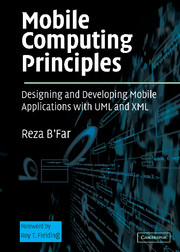Book contents
- Frontmatter
- Contents
- Foreword by Roy T. Fielding
- Acknowledgments
- SECTION 1 INTRODUCTIONS TO THE MAIN TOPICS
- SECTION 2 DEVICE-INDEPENDENT AND MULTICHANNEL USER INTERFACE DEVELOPMENT USING UML
- SECTION 3 ADDITIONAL DIMENSIONS OF MOBILE APPLICATION DEVELOPMENT
- SECTION 4 PUTTING THE PROJECT TOGETHER
- Chapter 15 The Mobile Development Process
- Chapter 16 Architecture, Design, and Technology Selection for Mobile Applications
- Chapter 17 Mobile Application Development Hurdles
- Chapter 18 Testing Mobile Applications
- Chapter 19 A Case Study
- References
- Index
Chapter 18 - Testing Mobile Applications
from SECTION 4 - PUTTING THE PROJECT TOGETHER
Published online by Cambridge University Press: 03 September 2009
- Frontmatter
- Contents
- Foreword by Roy T. Fielding
- Acknowledgments
- SECTION 1 INTRODUCTIONS TO THE MAIN TOPICS
- SECTION 2 DEVICE-INDEPENDENT AND MULTICHANNEL USER INTERFACE DEVELOPMENT USING UML
- SECTION 3 ADDITIONAL DIMENSIONS OF MOBILE APPLICATION DEVELOPMENT
- SECTION 4 PUTTING THE PROJECT TOGETHER
- Chapter 15 The Mobile Development Process
- Chapter 16 Architecture, Design, and Technology Selection for Mobile Applications
- Chapter 17 Mobile Application Development Hurdles
- Chapter 18 Testing Mobile Applications
- Chapter 19 A Case Study
- References
- Index
Summary
Common sense is the collection of prejudices acquired by age eighteen.
Albert EinsteinAll sects are different, because they come from men; morality is everywhere the same, because it comes from God!
VoltaireINTRODUCTION
Proper testing and quality control of software has been said to be one of the most neglected areas of software development. Whereas this streamlining of testing and quality control can reduce the budget and the time frame for delivery of projects, the quality of the delivered product is ultimately sacrificed. Although lack of testing and quality control can be the cause of failure, or at least customer dissatisfaction, of many software products, it has been tolerated in the world of PC applications. This is mostly due to the tolerance that the users have to buggy software with stability and functionality issues. However, this tolerance does not exist in the world of mobile application development. Mobile devices are always looked upon, even if they are not, as embedded devices. To the users, there is no difference between a way a PDA, a cell phone, and a VCR should operate: The user interface must be simple and there is zero tolerance for problems relating to security, stability, performance, and all of those other things that these same users have built an immunity toward during the usage of PCs.
- Type
- Chapter
- Information
- Mobile Computing PrinciplesDesigning and Developing Mobile Applications with UML and XML, pp. 792 - 805Publisher: Cambridge University PressPrint publication year: 2004



